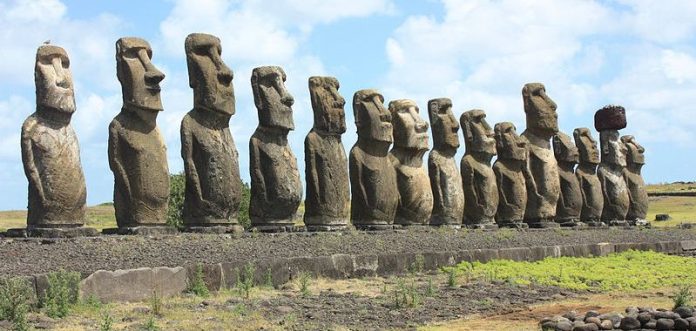Nestled in the vastness of the Pacific Ocean lies a remote island shrouded in mystery and intrigue: Easter Island. Renowned for its enigmatic stone statues called moai, this isolated landmass has captivated the imagination of adventurers, archaeologists, and tourists alike. In this blog, we embark on a journey to uncover the secrets of Easter Island, delving into its rich history, cultural significance, and the enduring mysteries that continue to baffle experts.
1. The Discovery of Easter Island:
– Easter Island, known as Rapa Nui to its indigenous inhabitants, was first discovered by Dutch explorer Jacob Roggeveen on Easter Sunday in 1722.
– The island’s remote location, situated over 2,000 miles from the nearest inhabited landmass, contributed to its isolation and preservation of its unique cultural heritage.
2. The Moai Statues:
– One of the most iconic features of Easter Island is its collection of monumental stone statues known as moai.
– These imposing figures, carved from volcanic rock, range in height from a few feet to over 30 feet and are believed to represent deified ancestors or tribal leaders.
– The construction and transportation of these massive statues remain a subject of debate, with theories ranging from human labor to the implementation of innovative engineering techniques.
3. Rapa Nui Culture and Society:
– The indigenous inhabitants of Easter Island, the Rapa Nui people, developed a complex society centered around agriculture, fishing, and the worship of ancestral spirits.
– Their culture thrived for centuries, producing intricate petroglyphs, ceremonial platforms called ahu, and the iconic moai statues that dot the landscape.
– However, environmental degradation, deforestation, and societal upheaval led to the decline of Rapa Nui civilization, leaving behind a legacy shrouded in mystery.
4. Theories and Interpretations:
– Archaeologists and historians continue to study Easter Island to unravel the mysteries of its past and the enigmatic disappearance of its inhabitants.
– Theories abound regarding the construction of the moai, the causes of societal collapse, and the role of external factors such as European contact and disease.
– Ongoing research and excavation efforts shed new light on Rapa Nui’s history and offer fresh insights into the island’s cultural heritage.
5. Conservation and Preservation:
– In recent years, efforts have been made to preserve Easter Island’s archaeological sites and protect its natural environment.
– UNESCO designated Rapa Nui a World Heritage Site in 1995, recognizing its cultural significance and promoting sustainable tourism and conservation practices.
– Collaborative initiatives between local authorities, indigenous communities, and international organizations aim to safeguard Easter Island’s heritage for future generations.
Easter Island remains an enduring enigma, a testament to the ingenuity and resilience of its ancient inhabitants. As we unravel the mysteries of this remote island, we gain a deeper understanding of humanity’s rich cultural tapestry and the importance of preserving our shared heritage for generations to come.
6. Modern-Day Exploration and Tourism:
– Despite its remote location, Easter Island has become a popular destination for tourists and researchers eager to uncover its secrets.
– Visitors can explore the island’s archaeological sites, hike along scenic trails, and immerse themselves in the vibrant culture of the Rapa Nui people.
– Archaeological expeditions and ongoing excavations provide valuable insights into Rapa Nui’s history and contribute to the global understanding of ancient civilizations.
7. Cultural Revival and Indigenous Identity:
– In recent years, efforts have been made to revitalize Rapa Nui culture and preserve the traditions of the island’s indigenous inhabitants.
– Initiatives such as language revitalization programs, traditional arts and crafts workshops, and cultural festivals celebrate the rich heritage of the Rapa Nui people.
– By reclaiming their cultural identity and asserting their sovereignty, the Rapa Nui community seeks to ensure the preservation of their ancestral legacy for future generations.
8. Sustainable Development and Environmental Conservation:
– As tourism continues to grow on Easter Island, there is a growing emphasis on sustainable development and environmental conservation.
– Local authorities, in collaboration with international organizations and conservation groups, implement measures to mitigate the impact of tourism on the island’s fragile ecosystem.
– Initiatives such as waste management programs, renewable energy projects, and responsible tourism practices aim to protect Easter Island’s natural beauty and biodiversity.
9. The Legacy of Easter Island:
– Easter Island’s enigmatic allure continues to captivate the imagination of people around the world, inspiring awe and fascination.
– Through ongoing research, conservation efforts, and cultural revitalization initiatives, the legacy of Easter Island endures as a testament to the ingenuity, resilience, and creativity of its ancient inhabitants.
– As we unravel the mysteries of Easter Island, we gain a deeper appreciation for the interconnectedness of human history and the importance of preserving our cultural heritage for future generations.
Conclusion:
Easter Island stands as a symbol of humanity’s enduring quest for knowledge and understanding. From the towering moai statues to the vibrant culture of the Rapa Nui people, this remote island holds a wealth of secrets waiting to be discovered. As we continue to explore, preserve, and celebrate the legacy of Easter Island, we honor the remarkable achievements of its ancient inhabitants and embrace the mysteries that enrich our shared human experience.























